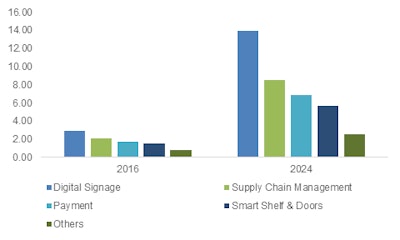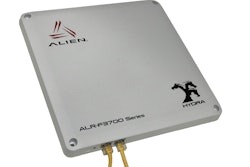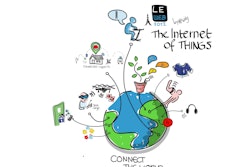
The Internet of Things (IoT) in retail market growth is set to exceed $30 billion by 2024, according to a new research report by Global Market Insights.
Increasing adoption of IoT by retailers to enhance the customer experience, reduce costs and improve overall performance is expected to drive the IoT in retail market growth over the forecast timeline. The rising trend of digitization across the retail sector, coupled with the increasing usage of smart devices, contributes significantly to the industry growth. In order to gain shopper insights and understand the buying behavior and deliver customized offers and promotions, retailers are increasingly deploying such solutions.
IoT has enormous potential to transform the retail industry. The various benefits include efficient store management, tracking and monitoring inventory, and improvements to store security and loss prevention. Automated check-out, tracking the product quality and optimized supply chain management are among the other benefits of implementing the technology. Growing internet connectivity across various regions, coupled with the increasing adoption of smartphones, is anticipated to propel the IoT in retail market growth. Factors such as gradual decline in prices of components, such as RFID tags and sensors, also is expected to contribute to the adoption.
Concerns related to data security and privacy might hinder the IoT in retail market growth. The high cost associated with the implementation, coupled with the interoperability of devices in the system, also is anticipated to curb the demand for such technological solutions.
Increasing installation of IoT solutions by retailers is expected to drive the adoption of connectivity technology such as Bluetooth Low Energy (BLE) in the IoT in retail market. It identifies the registered customers when they enter the stores and send messages which include customized promotions and offers. BLE is generally used for applications which need exchange of data in low volume and consumes less power as compared to that of Bluetooth.
In addition, wide adoption in applications such as digital signage mainly used for advertising and marketing is expected to fuel the IoT in retail market growth. Advantages of digital signage include offering the customers an interactive shopping experience and making the innovative advertisements available to the masses in reduced time. The intuitive touch screen offering the customers personalized and relevant content is anticipated to play an additional role in the IoT in retail market growth.
Asia Pacific IoT in retail market is expected to witness significant growth pertaining to the retail sector in economies such as China, Japan and India. Increasing disposable income of the middle-class population residing in those economies, coupled with the growing user base of smartphones, lies impetus to the industry growth in the region. Factors, such as improving the customer experience, followed by speeding up the check-out process, is the main reason for implementing such solutions by the retailers.
North America, being the largest market for retail is expected to grow considerably. This is attributed to the early technology adoption, combined with the presence of an organized retail sector in the region. The retailers in the region mainly focus on enhancing the supply chain performance by heavily investing in technologies such as automated inventory verification.
Companies in the IoT in retail market comprise IBM Corporation, Intel Corporation, Microsoft Corporation, SAP AG, Zebra Technologies, Cisco Systems, Amazon Web Services (AWS). The players are making huge investments in research and development to gain eminence. Moreover, they are increasingly focused on enhancing the overall customer experience by innovating and differentiating the services.














